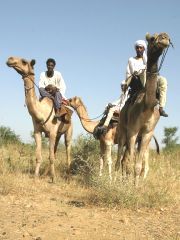Leading player in Darfur’s drama: The hapless camel
By MARC LACEY, The New York Times
Dec 5, 2005 (FAGOO, Sudan) — Sometimes one factor emerges as a defining element in a conflict: in history, salt, say, or gold; these days, hardy Toyota pickups or Stinger missiles.
 In Darfur, in western Sudan, the war that broke out in 2003 has been shaped by camels.
In Darfur, in western Sudan, the war that broke out in 2003 has been shaped by camels.
Those towering creatures, which roam the desert region by the tens of thousands, have long been a source of tension between the nomads and farmers who compete for dwindling resources in a harsh terrain of swirling sand. When herds of the herbivorous camels, together with cows, goats and sheep, tread on farmers’ precious crops, fury is the inevitable byproduct.
A rivalry, which had lasted decades, between the farmers and the nomadic herders exploded into full-fledged war nearly three years ago.
Camels became one of the weapons in the nomads’ arsenal against antigovernment rebels fighting for the rights of farming communities.
The militias that raided farmers’ villages frequently arrived on camelback, firing guns from atop the camels’ humps as government soldiers backed them up from trucks and aircraft. (The raiders are called janjaweed, a term referring to an armed outlaw on the back of a horse – or camel.)
Camels remain in the middle of the action. The heavily armed factions that control the Darfur countryside regularly steal other people’s camel herds or make retaliatory strikes to recover their own. In one incident, rebels in southern Darfur stole 2,000 camels in August in the tiny village of Malam, prompting militia fighters to retaliate. Forty people died in the mayhem, according to aid workers.
Most of Darfur’s nomads come from Arab tribes, and most of the farmers from African ones. Intermarriage is usually scoffed at – not out of hatred, one Arab nomad suggested, but out of more practical considerations. Arab women, the nomadic leader said, are raised on the backs of camels and are more compatible with nomadic men.
On a dried-out riverbed in Fagoo, a settlement of nomads in northern Darfur that appears on no official maps, Issa Ahmed Alshaib sat on a straw mat the other day looking glum. It was his wedding day, but he and the other men resting in the shade were lamenting lost camels and a disappearing way of life.
Since the war began, they said, scores of their camels have been stolen. Camels, which typically live three decades, mean everything to them, the camel herders said. The disappearance of even one is a misery.
Darfur’s camels provide transportation for the nomads as well as milk and meat. They are a form of wealth in remote areas where Sudanese dinars, the official currency, are hard to find. The camel herders of Darfur give their animals names and sometimes elaborately decorate them during their nomadic treks. If a man sees one of his camels being stolen and does not risk his life to recover it, he is an embarrassment to the tribe, nomads say. The man’s wife would have reason to leave him, they say.
“We’re suffering so much,” said Mr. Alshaib, who had just given the family of his fiancée six camels and one cow for her hand.
Mr. Alshaib’s bride, a teenager named Guimar Musa Salim, comes from his tribe, the Riziegat, and grew up as he did, roaming the countryside tending the family’s herd. It is a way of life that is dying in Darfur because the war has cut off nomads’ migration routes and severed most nomads’ links to farming communities.
In the old days, before the fighting broke out, farmers and nomads relied on one another despite the tension between them. Nomads would arrive at the farmers’ markets with what they had in abundance – meat and milk, from goats and cows as well as camels. They would trade for fresh produce and for medicines – for them and their animals.
But now nomads remain in the hinterlands, grumbling that the international aid coming to Darfur seems to go only to the farming communities.
That is largely true. The African farmers ousted from their villages in a brutal government-backed campaign to root out rebels and their sympathizers now live in camps for displaced people. Aid organizations provide them with food, schools and clinics.
The nomads say they feel ignored. Unicef is one organization that has made inroads in nomadic communities, providing mobile schools and drilling wells along migration routes.
“There’s a growing sense that we need to help the nomads, and the blanket portrayal of them as all janjaweed is pretty false,” said Dorn Townsend, a Unicef field worker.
Setting aside designated migration routes for the nomads and their herds is widely considered a crucial element of a peaceful Darfur. Musa Dudu, who has 3 wives and 15 children, a family that helps him tend a herd of 80 camels, reflects the complicated nature of the Darfur nomad.
Mr. Dudu was loading up his camels the other day, moving west toward Kebkabiya, away from a mountain range where he said rebels were lurking. As he and his relatives tore down the family’s tents and packed their possessions onto camels, he described himself as a victim in this war, not an aggressor.
But among the things he packed were a camouflage jacket and an automatic weapon, both government issue. He acknowledged that he was a member of the self-defense forces that the government had commissioned to fight on behalf of nomads. That is, the janjaweed.
“People are attacking me,” he said, poking the chest of his visitor. “I’m just trying to live. How does that make me a janjaweed? I’m just a father. I’m just a nomad. I don’t want this war.”
Soon, he was off, traversing the troubled landscape of Darfur as so many here do, on camelback.
